5. Blue Steel (1990)
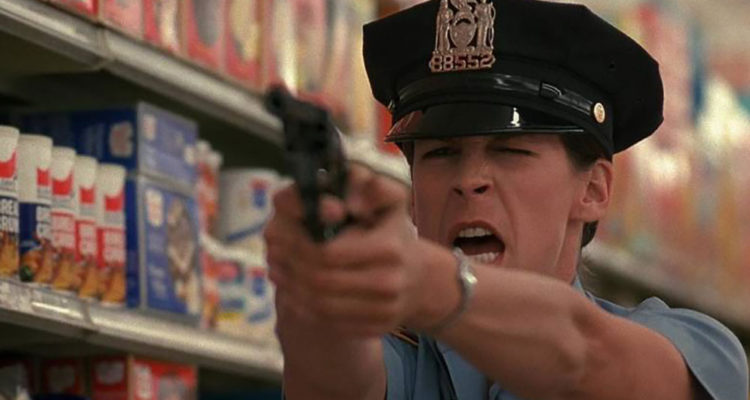
‘What would transpire if a police officer unknowingly started dating a murderer?’
This is the premise to Bigelow’s third feature, comparable to the psychological thrillers of Patricia Highsmith. Co-produced by Oliver Stone, it stars Jamie Lee Curtis in a soulful lead performance as Megan. A story that renowned critic Roger Ebert described as a “sophisticated update of Halloween”4 (Curtis’s breakout role). There’s also an early appearance from Richard Jenkins as a slippery lawyer. When she receives a threat, Megan becomes entangled in the investigation of a killer, conducted by her police colleagues. Meanwhile, her new love interest, Eugene, grows increasingly more sinister and dangerous. Like Bigelow’s previous feature, this is a fast-paced, wonderfully-acted film brimming with twists, suspense and beautifully-dactylic dialogue, establishing Bigelow’s aptitude within the action genre.
Amir Morkri’s helicopter shots of the Manhattan cityscape at night, and his capturing of the chimpanzee-like bedlam of the stock exchange paints an evocative portrait of New York City in the late ‘80s, early ‘90s. The film’s sound design effectively provides a visceral amplification of Megan’s heavy breathing in the tense stand-offs. Along with the selective hand-held camerawork and Sergio Leone close-ups, the sound builds nail-biting tension towards the action – shockingly, naturally brutal, rather than glorified. Though perhaps less notable and sensational than the other titles of Bigelow’s filmography, Blue Steel is definitely meritorious enough to justify its entry in to the pantheon of great ‘90s crime films. As with all her work, Bigelow’s execution is spotless and the story quickly heats up with adrenalin to an explosive slow-motion gunfight, rivalling the excitement of John Woo’s Hong Kong action pictures.
The main reason this film is exceptional is its yin and yang view of humanity. Whilst many thrillers deal with the infamy, bloodlust and glorification of its criminals, Blue Steel is special in that it sympathetically and realistically portrays the psychological transformation of a regular person in to a murderer. When Eugene finds a pistol, it serves as a metaphor for his loss of innocence, the thrilling temptation of a dark way of life, echoing Adam and Eve in the garden of Eden. Though Ron Silver’s performance as Eugene descends in to twisted terror, the character possesses many endearing qualities too: his romanticism, his poeticism, his original kindness towards Megan.
This balanced approach to character is also present in Megan’s monstrous father, Frank (Philip Bosco), who is physically abusive to her mother. Later, he suddenly displays heart-breaking vulnerability, showing a completely different side to his personality, humanising and deepening the complexity of his character. Through her humane and honest writing, Bigelow communicates that people are never just good or bad – we are all a mixture. Even the ‘evilest’ people can act with kindness. Can they attain redemption? Can we condemn them if we understand what they’ve endured and the substance of their heart? Crucially, Blue Steel shows us that life is grey, not black and white.
4. Detroit (2017)
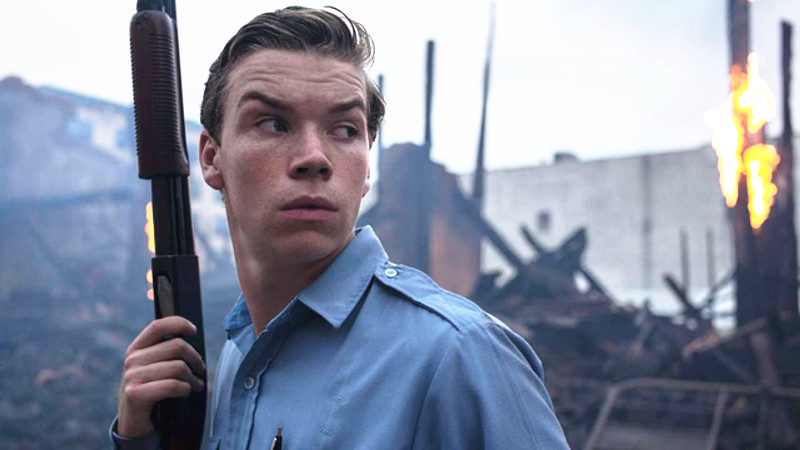
“If this [film] could perhaps start a bit of a conversation toward bridging a racial divide in [the USA], it was worth it. To do nothing was not an option.”
– Kathryn Bigelow.
Bigelow’s most recent directorial effort (to the date of this list’s publication) saw her re-teaming with Hurt Locker screenwriter Mark Boal for a historical crime film, set during the 1967 Detroit riot. It factually depicts the sharply-exacerbating racial tensions and conflicts between the African-American community and the city’s police force. The narrative is centred around a dramatisation of the real-life Algiers Motel incident. The feature is helmed by Algee Smith as Larry, a Motown singer, with talented British and Irish actors John Boyega, Will Poulter and Jack Reynor.
Detroit is perhaps Bigelow’s most important and emotionally-resonant piece, for its depiction of the inhuman, heart-breaking treatment of innocent African-American civilians by white police officers. This is aptly epitomised in one character’s statement: “when you’re black, it’s almost like having a gun pointed right at your face.” The extended Algiers motel sequence serves as a synecdoche for the atrocities inflicted upon black people at the hands of European-Americans throughout U.S. history, as well as the injustice, fear and violence they continue to face from the police today, drawing parallels to contemporary shootings.
What’s more, the monstrous racism of certain white American police officers is encapsulated by Will Poulter’s terrifying performance as the brutal, ignorant Philip Krauss, unlawfully and savagely executing African-Americans whenever he desires, for no reason. The message of the film is exemplified when his character places a knife beside the corpse of an unarmed man he’s just shot in cold blood. Detroit is a title that achieves a provocation of tears and outrage, vital in its education of the reality of institutional racism existing in the American police force and the justice system. On her intentions for the film, Bigelow elucidated: “my hope was that the legacy of [the people who were] killed at the [Algiers Motel] is no longer forgotten.”
Whilst all the actors perform on a very high level, John Boyega’s mature, introspective performance stands out, as he shows us his character’s inner conflict between his sympathy towards his fellow African-Americans and his duty as a security guard. Mainstays of Bigelow’s filmmaking, such as a successful cultivation of tension and hand-held camerawork, are suitably-placed within this picture. The latter component plants the audience right in the time period, making them feel as though they are experiencing the events first-hand. The film’s emotion is further augmented by interspersions of historical news footage from the actual riot.
Conversely, the war-zone tumult captured in Detroit unfortunately bleeds in to the film’s technical execution, occasionally making it feel slightly chaotic and unfocused. Additionally, it’s over-long, and feels as though its point could have been more concisely expressed within a shorter duration. Nonetheless, despite its undeserved status as a box office failure, (perhaps attributed to audiences’ fear of its serious, harrowing content) Detroit is sure to be remembered as a historically vital film, enlightening its audience substantially enough so that at least they will not repeat the tragic mistakes of history in the future. Again, Bigelow demonstrates that her capacity to entertain is just as potent as her aptitude in communicating essential, heart-felt social messages.
3. Near Dark (1987)
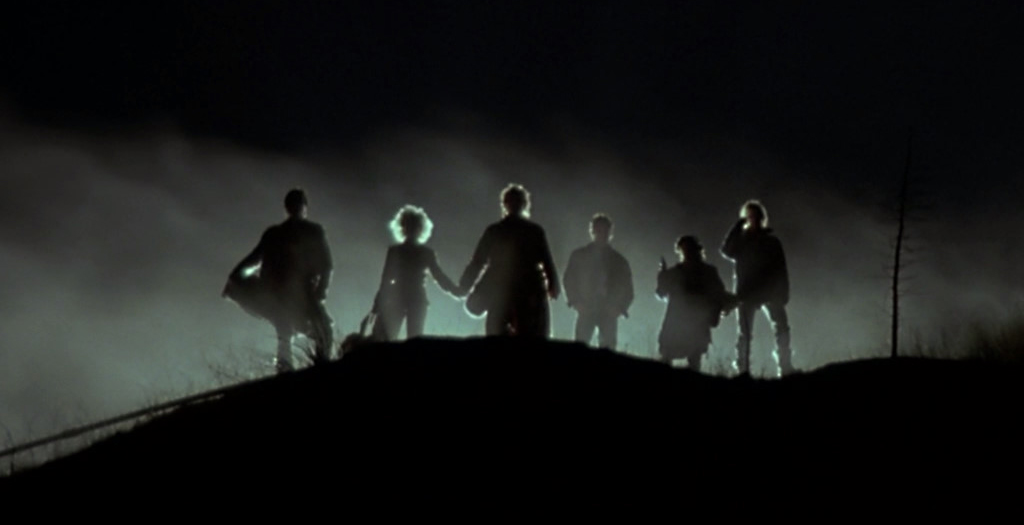
“The more [the characters] try to extract themselves from a situation, the deeper embroiled they become.”
– Bigelow on the film noir tradition.
For her second feature, Bigelow blended her interest in the horror, romance, neo-western and neo-noir genres to create a modern-day Bonnie and Clyde. Near Dark begins with a close-up of a mosquito sucking blood from human skin. One night, Caleb, a farm boy, meets the enigmatic Mae and they quickly fall in love. When Mae bites his neck, Caleb undergoes a transformation in to a vampire. He’s taken in by Mae’s surrogate family of outlaw vampire nomads, who rove around the country in an RV, wreaking blood-sucking havoc. Caleb struggles to adapt to his new form and lifestyle, and is torn between his love for Mae and his desire to return home.
Expanding upon the Nihilistic neo-noir universe Bigelow birthed in The Loveless, Near Dark is a nearly flawless movie with much to love, a must-watch for horror fans and one of the best vampire films ever made. Unlike Bigelow’s debut, it is focused, fast-paced, action-packed, concisely-written and expertly-plotted, demonstrating Bigelow’s artistic maturity, even on only her second feature. Beneath the Peckinpah-style action and anarchic, punk rock tone, there exists an innocent, sweet romance between Caleb and Mae, beautiful in its purity and their strong commitment to one another. Of the film’s many highlights, some include: Caleb’s white horse rearing up when it meets Mae, sensing her vampirism (an example of Bigelow’s novel creativity and originality in her attention to detail), the moody chiaroscuro of the Mitchum era-inspired lighting, Tangerine Dream’s synth soundtrack, and Davida Simon and Gordon J. Smith’s grisly, hellishly-perfect make-up work.
The most admirable aspect of the film, however, is how it humanises rather than mythologises vampires, as most other horrors have seemed to do. With realism, it shows how agonising the transformation in to a monster is for the nice, clean-cut Caleb, the enormous remorse he feels when having to kill humans to survive, and his loving father’s moving grief over his son’s affliction. Overall, this expresses a comparison to the painful guilt felt when one takes a human life in reality. This makes Near Dark an important film thematically, as it informs audiences about the true psychological consequences of murder, for victim and perpetrator alike. The film’s violence never seems gratuitous; it’s well-placed, pertinent to the motivations of the characters and plays an important role in the plot’s progression, like a Hitchcock thriller. Unlike many horror films of the ‘80s, it’s tastefully only gruesome when it needs to be, and there’s a far greater thematic weight behind it.
Of the performances, the highlight is Joshua John Miller as the sly, desperate Homer – a very old vampire eternally imprisoned inside the body of a little boy. Despite only being thirteen at the time of the film’s release, Miller’s performance is starkly-mature, natural, profound, chilling, yet funny, comfortably placing him in league amongst the highest caliber of actors. His presence, aided by his unusual backstory, juxtaposing his appearance with his character, is dominating. This is embodied when he sprawls belly-down across the gang’s table at the bar, and in the adult intensity of his gun-toting rage. He commands the audience’s attention in every scene he’s in, and, like all great actors, is demonstrative of what is possible when one stretches the limits of the craft using powerful raw emotion. Such is his skill, it is frightening how advanced, genius and show-stealing his acting is – at his, or any age.
Since its release, Near Dark has left a noticeable impact on other filmmakers, visible in Rob Zombie’s Firefly trilogy. Quentin Tarantino noted that it was an influence on his style and one of the few exciting movies to redeem ‘80s cinema for him. Perhaps the only criticism of this film is that there isn’t a great deal of depth to or development of the characters. Despite this, it makes up for it through its perfection in every other field. Near Dark’s humane and radical deconstruction of the vampire genre continues to broaden the possibilities of contemporary horror cinema, even today. Due to its critical acclaim, this was the movie that solidified the observance of Bigelow’s acumen, and without it, she couldn’t have gone on to make the larger-budget action films she’s become known for. It’s a movie guaranteed to intrigue, excite and entertain, with never a dull moment.
2. Zero Dark Thirty (2012)
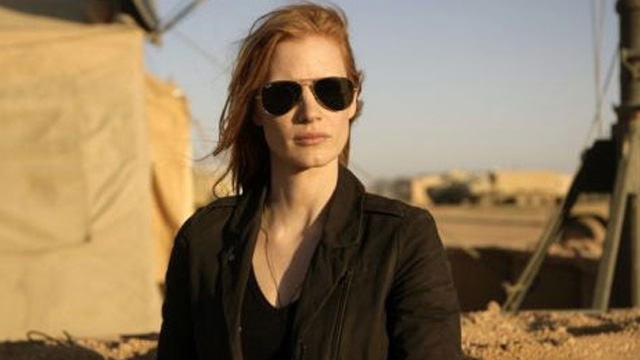
“A portrait of dedication and courage.”
-Kathryn Bigelow.
Academy Award winner Jessica Chastain plays Maya, a fictional CIA analyst helming a manhunt for Osama bin Laden from 2003 to 2011. Aside from Chastain’s outstanding, serious, muscular performance, the film celebrates the stunning work of adept yet underused character actors Jason Clarke, Kyle Chandler, Jennifer Ehle, Fares Fares and the late, great James Gandolfini. A critical and commercial triumph, Zero Dark Thirty’s accuracy attracted controversy from the Republican Party, who alleged the filmmakers had access to classified information. The movie was released only a year and a half after the actual assassination of bin Laden.
Unlike the majority of cinematic protagonists, Maya displays deeply-reprehensible traits in conjunction with her qualities, such as her ratification of and participation in the barbaric torture methods used by the CIA to obtain information, echoing the atrocities of Abu Ghraib prison. By this token, Zero Dark Thirty, like Blue Steel, provides a balanced, complex view of human nature that defies simple explanation. As well as chronicling the pursuit of the world’s most notorious mass-murderer, the film poses the question: what makes a terrorist? Is this categorisation defined by groups such as Al Qaeda, or can the inexcusable overseas violence continually perpetrated by America similarly be called acts of terror? Because one of the belligerents claims to be on the side of ‘good,’ does that not make them culpable for their bloodshed? These questions are surmised in the reactions of the targets’ children, whilst the animalistic treatment of America’s prisoners is distilled in the passing imagery of monkeys contained in a tiny cage.
The movie’s documentary-like camerawork captures the texture of Pakistan and is aided by the succinct, fluid editing that moves the film at a machine gun fire pace. Night vision photography is also adroitly embraced to forge an atmosphere of anxiety. Far transcending the merits of a traditional action picture, Zero Dark Thirty uses violence to articulate the moral heaviness of the events and the effects it has on its victims. Due to being based on a true story, the film is unpredictable and not structured like a work of fiction, making the action shocking and realistic. Zero Dark Thirty also boasts one of the tensest, most memorable, well-filmed climaxes in cinema history, brought to life with the endearing, macho portrayals by Joel Edgerton and Chris Pratt, who contribute to grounding this historic event to a relatable human experience. Furthermore, the film is a testament to the detail of the filmmakers’ research, noticeable in everything from the technology used, to the parlance of the special ops.
Garnering Bigelow her second Oscar nomination for Best Picture, in this timely, monumental achievement she intelligently and sensitively dramatises the unknown inner workings of a world famous event, continuing to prove what an exceptional director she is. Through Maya, she guides the audience through the monumental emotions that these events carried. Whilst gifting audiences with an impeccably gripping war film, Bigelow further pays tribute to the immense hard work of those involved in finding bin Laden and the casualties the search incurred. Zero Dark Thirty’s perfection is only hindered by the inappropriate use of Arabic by Pakistanis, when they would typically be speaking Urdu, Punjabi, or one of the many other languages spoken in the country.
1. The Hurt Locker (2008)
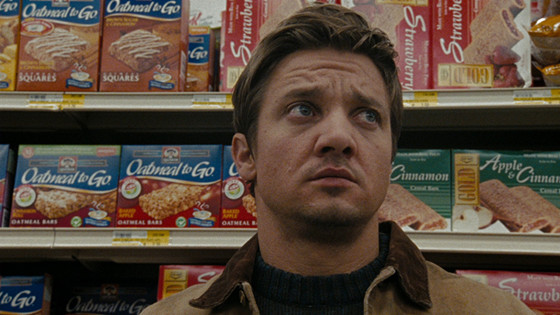
Winner of six Academy Awards, including Best Director and Best Picture, Bigelow’s magnum opus stars Jeremy Renner as the reckless Sergeant William James, as he leads a bomb disposal unit on the deadly streets of Baghdad at the height of the Iraq War. Frequent Bigelow collaborator Mark Boal based the screenplay upon his experiences as a journalist accompanying a bomb squad during the conflict. It remains one of the greatest war films ever made and, in 2020, was selected for preservation by the Library of Congress for being culturally, historically, or aesthetically significant. It was filmed in Jordan, only a few miles from the Iraqi border, whilst the war was still occurring. Actual Iraqi refugees were used as extras, contributing to the film’s tragic verisimilitude.
A career and decade-defining work, The Hurt Locker is a masterclass in suspense, seizing the audience’s attention with a vice-like grip, exponentially raising their heart rate throughout its duration and not relinquishing its hold until the closing credits. Like a great horror movie, it cultivates a fearful atmosphere where everyone is suspicious and no one can be trusted. A bomb detonation or a shootout feels imminent at any time. As with Zero Dark Thirty, The Hurt Locker surpasses the remit of a classic action film, elevating the genre with its historical significance and depth of meaning. Unlike other war films, it’s as intimate as a theatre play and seeks to shock with its devastating violence and provoke debate about the war, rather than entertain with bloodshed. Though it has all the strengths of a mainstream war feature and more, it’s enriched with the artistic individuality and vitality of an independent film. Like all of Bigelow’s work, it was independently financed and not dictated by a studio.
Here, Bigelow masters her signature use of handheld camerawork, making The Hurt Locker a breathtakingly visceral experience, furthered by the focus and brevity of its editing. In reference to the cinematography, Bigelow explains that she wanted the film to feel “immediate and unfolding in front of you in real time. To do that, you need to put the audience in the shoes of [the characters].”8 Indeed, as in Detroit, the involving camerawork allows the audience to feel like they too are caught in the maelstrom of the Iraq War. Moreover, the use of poignant close-ups succeed in highlighting the vulnerability of the characters in moments between their duties. Nothing in the film feels forced. On the contrary, the lack of cliched narrative devices and the natural progression of the story adds to its realistic impression. The dialogue is also natural, not overwrought and always essential to the plot.
The Hurt Locker depicts the pain and casualties on both sides of this conflict, stating a pro-human protest against war. It provides insight in to the horrors that transpired in Iraq in the 2000s, treating all of its characters, American and Iraqi, with empathy, understanding and journalistic neutrality. The dismay, fear and anger of the Iraqi population at the occupation of their country broadens a western audience’s comprehension of the bifurcations of America’s crusade in the Middle East. This is typified when William invades of the home of a friendly Iraqi professor. William continues to interrogate and aim his gun at him, whilst the professor politely offers him his hospitality. This symbolises how innocent Iraqis suffered at the hands of the American military.
Additionally, this is the first title of Bigelow’s that can be dubbed an in-depth character study, magnifying the personalities of the three men in the bomb squad. It examines the psychology of individuals who are addicted to danger, explaining how ordinary people are indoctrinated in to becoming killers. On the other hand, true to Bigelow’s intelligence, the film also shows the incredible valour and positive impact of many dedicated U.S. servicemen and women as they strove to restore peace to Iraq. As well as Renner’s spellbinding acting, Anthony Mackie and Brian Geraghty’s truthful performances function as the eyes and heart of the audience, voicing their concerns and embodying their emotions. Importantly, their characterisations build pathos in regard to the enormous trauma that soldiers accrue from their war experiences, charged with taking dozens of lives, and how negatively this effects them in the long-term. In addition, young Christopher Sayegh’s precocious performance as Beckham is notably proficient, adding humour to the film’s otherwise insatiably gritty tone. There’s also a brief but laudable appearance from Ralph Fiennes as an understated mercenary.
The Hurt Locker is a testament to Bigelow’s preeminent skill as a filmmaker, where she achieves perfection on all fronts; specifically in how her direction extorts superlative performances from her cast. She has reached the zenith of her abilities, creating a work that is as engrossing as it is meaningful.